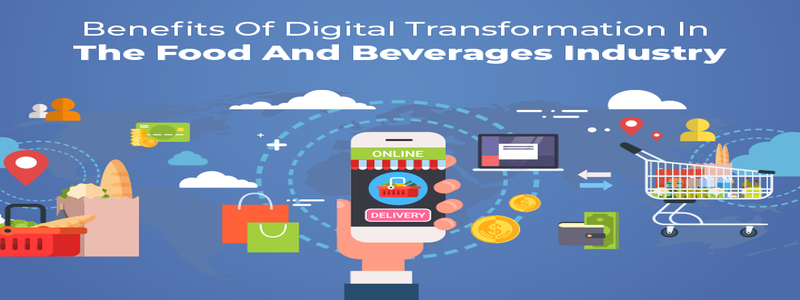Shailender Khanna – Domain Expert (F&B ) – A skilled culinary professional with a proven track record, recognized for a comprehensive knowledge of international cuisine and an innovative approach to setting the stage for a customized experience in Cloud Kitchens, Restaurants, and Banquets.
Having worked in hotels like Renaissance, Marriott, Novotel he got exposed to the buy-produce-sell side of the process and then utilized them to help Cure.fit to establish their SOP’s for managing their cloud kitchens. He also founded a pickle production unit – Achari by Pōṣā.
He is a tech enthusiast now working with All e Technologies a Microsoft Business Application service provider, exploring Microsoft Technology stack Dynamics 365, Aptean’s F&B Solution to create recipes for digital transformation in F&B Industry
Top 5 Benefits of Digitizing a Food Business
Being a successful food or beverage manufacturer in 2021 is no small feat. It necessitates a well-managed supply chain and demand, as well as quality control and the ability to respond to a rapidly changing sector.
The Food and Beverage Service industry is a highly dynamic industry that is still developing, with a shift in trends every couple of years, this is where Digital transformation can create a real value for businesses that manufacture, distribute, deliver, and sell Food and Beverage products.
Leveraging the benefits of Digital Transformation with the use of Cloud-based solutions is the perfect resolute conclusion to industry efficiency, output, safety, and maximizing the capacity of the manufacturer, and helping the Food and Beverage industry grow to its maximum prospects.
The Industry Specific Artificial Intelligence elements and functionality in ERPs Like Aptean food solutions built on Microsoft Dynamics 365 Business central are helping companies to increase food safety, improve traceability, reduce wastage, and lower costs and hazards at various phases of food processing and packaging are all goals.
To enhance efficiency and production, the next-generation manufacturing plant (which is currently here) will use digital technologies. Customers will grow to demand a certain level of service as more production facilities use new technology.
Let’s Dive into the Top 5 Benefits of digitizing the food manufacturing business.
1) Overall Operational Efficiency
Operations management in the manufacturing industry is becoming more nimble. After the pandemic crisis of 2020, the industry’s top concern is to get back to normal.
Furthermore, firms are implementing innovative process methodologies to cut operational costs.
It includes:
- Reducing wastes
- Making your storage smarter
- Raising Productivity
- Streamlining workflow
- Improving processes to boost production
- Stable operations
- Overhead efficiency improvement (Electricity | Maintenance, etc.)

Industries focus through the years have been on Individual KPI to improve these factors and Improve Top and bottom line of businesses.
When this data is available in real-time, with trends easily visible as an overview, decision making not only improves backed on data but also the efficacy of those decisions taken at the correct times; compound and improve overall business attributes right down to the smallest of processes.
The digital transformation of the food industry, as well as the food and beverage manufacturing industry as a whole, has changed the way operations are managed.
For example, it helps to monitor real-time data, optimizes efficiency, improves production, improves quality & compliance, and so on.
2020 was a tough year for most businesses, to say the least. Some things you simply can’t see coming. However, you can ensure that your company is prepared to face whatever tomorrow may bring.
The ability to pivot and change strategies and to do so quickly is becoming an important necessity for any business. In every step of the supply chain, increased disruption and market turbulence offer opportunities for error. Being ready and prepped for the future is critical for any operation, but getting prepared is where digital transformation plays such an important role. Without the worry of uncertainty, digital transformation means you have the tools you need to deal with the industry as it is today and the issues that may arise in the future. You can simply scale your firm and deal with unexpected events. Because you already have everything you need with digital transformation.
2.) Food Safety and a customize-able Food Recall and traceability system
The food services and manufacturing industries have evolved to accommodate the fast-increasing need for safe, nutritious, and flavourful food to feed the world’s roughly 8 billion people.
Food supply systems stretch halfway around the world to reach people in far-flung locations with a vast range of fresh and frozen foods. To match consumer preferences and schedules, food shops are increasingly offering precooked food options for takeaway and home delivery. Researchers and scientists are also looking at novel ways to replace resource-depleting dairy and animal products with plant-based and laboratory-grown ingredients.

What role does digital technology play in improving food safety efforts?
Almost all laws and practices aimed at ensuring the safety of food and food practices are based on having current and correct information. As a result, modern digital technology can offer a clear and practical solution to the current food safety difficulties that food manufacturers, distributors, and retailers face. Here are just a few examples of how digital technology is being used to help food safety operations be more successful.
- Mobile devices and Apps— Mobile devices and apps are becoming increasingly common in our culture, with an increasing number of people relying on them for many key parts of their professional and personal life. Specialized apps can replace traditional “pen and paper” ways of collecting and keeping routinely obtained data like storage temperature measurements, inventory levels, quality assurance checklists, and much more in the food business.
- Digital auditing tools— Digital auditing tools and platforms, which use data acquired through mobile devices and apps, give a more efficient, accurate, and cost-effective alternative to paper-based auditing approaches. Digital auditing tools not only eliminate the challenges of reading and understanding hand-written notes, but they fully support the ability to organize and evaluate data in a meaningful way, facilitating the prompt identification of potential safety issues. In addition to reducing space, digital auditing solutions eliminate the need to keep and retain paper information.
- Digital product labeling— In the food business, digitized product labels with QR (quick response) codes are quickly gaining traction. They can be instantly scanned using a smartphone app to provide immediate, accurate, and up-to-current information on the composition or ingredients of food products, the date, and location of manufacture, or the results of any appropriate food safety testing that has taken place. Digital product labels are also nearly impossible to alter or replicate, which is especially critical for food varieties that are vulnerable to counterfeiting.
- Data & Record-Keeping— Systems can be used to maintain records on the provenance of food ingredients such as the country of origin, producer-specific information, Food inspection, testing, and certification results, as well as production and production batch codes. Records are securely maintained in an online ledger and are easily retrievable by authorized users.
Food safety specialists can more readily spot possible safety risks using digital technology solutions, which have considerable advantages over legacy methods of collecting and keeping a wide range of current food safety data. The issue is that all these food industry innovations also bring about new challenges when it comes to providing food safety and safe food.
Food raw materials, as well as ingredients and finished products, can be exposed to chemical or biological contamination all along the supply chain due to substandard handling, poor chilled storage or environmental controls, and inadequate transportation processes. Insufficient or haphazardly applied cleaning & sanitation practices among food handlers can transmit salmonella or E-coli, contributing to food-borne illnesses.
With Innovation in food, there is the innovation behind processes of inspection and regulation of food and beverage products, which means that a willingness to adapt and innovate is critical to your operations. Because it is no legally recognized, set-in-stone traceability scheme, this shift away from prescriptive requirements may be beneficial. As we previously discussed, bespoke systems are essential because your company has unique complications and obstacles.
You have the option to seek a custom solution that is tailored to your company’s exact requirements. Key benefits include greater potential for improving value chain efficiency and lowering costs. Also, there will be great effectiveness at isolating and preventing contaminated products from being in the production line and then reaching your customers. The latter will do only wonders for your brand equity – something which is invaluable in the food industry especially in an age when competition is aggressive than ever to secure the trust of future customers.
3) Scale as you grow
There is a common misconception that the digital transformation initiative only applies to enterprise-size companies and is not applicable to smaller businesses.
This is actually an incorrect perception, by synchronizing digital transformation tools together, you can save wastage and scale faster as your business grows.
Legacy systems that weren’t built to scale become a roadblock, resulting in missed opportunities and costly re-platforming while allowing your competitors to gain a competitive advantage. Combining digital tools creates a powerful and cost-effective toolkit that scales with your organization by providing a stable foundation for all of the business’ variables.

4) Gaining Faster Return On Investment
Money talks, and as Food Manufacturing business owners, we have to listen.
Implementation of new technologies is at most times very costly and could take years to produce a measured return on investment. Translating strategy into metrics can be challenging, but with digital transformation, come real-time insights into every area of your business operation and beyond. Faster ROI analysis enables you to gain and access immediate impact from quick-turn applications of these platforms.
You must calculate the amount of new revenue generated as a result of your recent digital investment. It’s the only way to ensure that digital transformation pays off. We know it’s true, but don’t take our word for it; look up the statistics yourself.

5) Communication
Millions of workers were forced to work remotely as a result of the pandemic issue. The key bottleneck factor to consider is effective remote communication.
As a result, over 60% of industries have implemented digital tools to centralize communication. Manufacturing industries reaped higher benefits from digitization in order to sustain and improve productivity.
– It keeps workflow intact and productivity is not negatively impacted.
– It encourages individuals and departments to communicate data more effectively.
– Allows access at any time and in any location.
Digitization has diminished the limitations of inter-connection.
Communication is key.. really, it is! Tools that streamline the numerous lines of communication in your business, whether that communication is between your systems, your workers, your customers, or partners, are part of an efficient digital transformation toolbox.
By integrating your systems, what is changed is the way systems communicate with each other and how that information flow is then communicated to the user. Your data is centralized and updated in real-time, and everyone uses the same data, allowing you to realize your full business potential. As a result, you may reduce blind spots, remove information transfer delays, and quickly identify bottlenecks.
Communication speed and quality can have a big impact on how long your company lasts. When your systems communicate seamlessly, it reflects in your customer communication, whether it’s through step-by-step order tracking, recall notifications or customer service. All of the information you need is in one place since you’re working from a single source of truth, which improves internal cooperation and streamlines customer communications.






Comments (0)